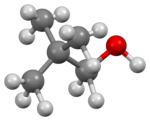Neopentyl alcohol is a compound with formula (CH3)3CCH2OH. It is a colorless solid. The compound is one of the eight isomers of pentyl alcohol.

| |

| |
| Names | |
|---|---|
| Preferred IUPAC name
2,2-Dimethylpropan-1-ol | |
| Other names
tert-Butyl carbinol
tert-Butylmethanol Neoamyl alcohol Neopentanol | |
| Identifiers | |
3D model (JSmol)
|
|
| ChEMBL | |
| ChemSpider | |
| ECHA InfoCard | 100.000.826 |
| EC Number |
|
PubChem CID
|
|
| UNII | |
| UN number | 1325 |
CompTox Dashboard (EPA)
|
|
| |
| |
| Properties | |
| C5H12O | |
| Molar mass | 88.150 g·mol−1 |
| Density | 0.812 g/mL at 20 °C |
| Melting point | 52.5 °C (126.5 °F; 325.6 K) |
| Boiling point | 113.5 °C (236.3 °F; 386.6 K) |
| 36 g/L | |
| Solubility | very soluble in ethanol, diethyl ether |
| Thermochemistry | |
Std enthalpy of
formation (ΔfH⦵298) |
-399.4 kJ·mol−1 |
| Hazards | |
| GHS labelling:[2] | |
 
| |
| Warning | |
| H226, H228, H319, H332, H335 | |
| P210, P233, P240, P241, P242, P243, P261, P264+P265, P271, P280, P303+P361+P353, P304+P340, P305+P351+P338, P317, P319, P337+P317, P370+P378, P403+P233, P403+P235, P405, P501 | |
| Flash point | 37 °C (99 °F; 310 K) |
Except where otherwise noted, data are given for materials in their standard state (at 25 °C [77 °F], 100 kPa).
| |
Preparation and reactions
editNeopentyl alcohol can be prepared from the hydroperoxide of diisobutylene.[3] It can also be prepared by the reduction of trimethylacetic acid with lithium aluminium hydride. Neopentyl alcohol was the first described in 1891 by L. Tissier, who prepared it by reduction of a mixture of trimethyl acetic acid and trimethylacetyl chloride with sodium amalgam.[4]
Neopentyl alcohol can be converted to neopentyl iodide by treatment with triphenylphosphite/methyl iodide:[5]
- (CH3)3CCH2OH + [CH3(C6H5O)3P]+I− → (CH3)3CCH2I + [CH3(C6H5O)2PO + C6H5OH
See also
editReferences
edit- ^ Lide, David R. (1998), Handbook of Chemistry and Physics (87 ed.), Boca Raton, Florida: CRC Press, pp. 3–228, 5–42, 8–102, 16–22, ISBN 0-8493-0594-2
- ^ "Neopentyl alcohol". pubchem.ncbi.nlm.nih.gov.
- ^ Joseph Hoffman (1960). "Neopentyl Alcohol". Organic Syntheses. 40: 76. doi:10.15227/orgsyn.040.0076.
- ^ Comptes Rendus, 1891, 112, p. 1065
- ^ H. N. Rydon (1971). "Alkyl Iodides: Neopentyl Iodide and Iodocyclohexane". Organic Syntheses. 51: 44. doi:10.15227/orgsyn.051.0044.